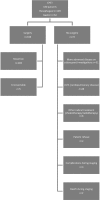Cardiopulmonary exercise testing as a predictor of complications in oesophagogastric cancer surgery
- PMID: 23484995
- PMCID: PMC4098578
- DOI: 10.1308/rcsann.2013.95.2.125
Cardiopulmonary exercise testing as a predictor of complications in oesophagogastric cancer surgery
Abstract
Introduction: An anaerobic threshold (AT) of <11 ml/min/kg can identify patients at high risk of cardiopulmonary complications after major surgery. The aim of this study was to assess the value of cardiopulmonary exercise testing (CPET) in predicting cardiopulmonary complications in high risk patients undergoing oesophagogastric cancer resection.
Methods: Between March 2008 and October 2010, 108 patients (83 men, 25 women) with a median age of 66 years (range: 38-84 years) underwent CPET before potentially curative resections for oesophagogastric cancers. Measured CPET variables included AT and maximum oxygen uptake at peak exercise (VO2 peak). Outcome measures were length of high dependency unit stay, length of hospital stay, unplanned intensive care unit (ICU) admission, and postoperative morbidity and mortality.
Results: The mean AT and VO2 peak were 10.8 ml/min/kg (standard deviation [SD]: 2.8 ml/min/kg, range: 4.6-19.3 ml/min/kg) and 15.2 ml/min/kg (SD: 5.3 ml/min/kg, range: 5.4-33.3 ml/min/kg) respectively; 57 patients (55%) had an AT of <11 ml/min/kg and 26 (12%) had an AT of <9 ml/min/kg. Postoperative complications occurred in 57 patients (29 cardiopulmonary [28%] and 28 non-cardiopulmonary [27%]). Four patients (4%) died in hospital and 21 (20%) required an unplanned ICU admission. Cardiopulmonary complications occurred in 42% of patients with an AT of <9 ml/min/kg compared with 29% of patients with an AT of ≥9 ml/min/kg but <11 ml/min/kg and 20% of patients with an AT of ≥11 ml/min/kg (p = 0.04). There was a trend that those with an AT of <11 ml/min/kg and a low VO2 peak had a higher rate of unplanned ICU admission.
Conclusions: This study has shown a correlation between AT and the development of cardiopulmonary complications although the discriminatory ability was low.
Figures




Comment in
-
Cardiopulmonary exercise testing as a predictor of complications.Ann R Coll Surg Engl. 2014 Jan;96(1):86. doi: 10.1308/rcsann.2014.96.1.86. Ann R Coll Surg Engl. 2014. PMID: 24417848 Free PMC article. No abstract available.
-
Author's response.Ann R Coll Surg Engl. 2014 Jan;96(1):86. doi: 10.1308/003588414x13824511649373. Ann R Coll Surg Engl. 2014. PMID: 24563960 Free PMC article. No abstract available.
References
-
- de Graaf GW, Ayantunde AA, Parsons SLet al The role of staging laparoscopy in oesophagogastric cancers. Eur J Surg Oncol 2007; 33: 988–992 - PubMed
-
- Jamieson GG, Mathew G, Ludemann Ret al Postoperative mortality following oesophagectomy and problems in reporting its rate. Br J Surg 2004; 91: 943–947 - PubMed
-
- National Oesophago-Gastric Cancer Audit 2010. Leeds: NHS Information Centre; 2010
-
- Lagarde SM, de Boer JD, ten Kate FJet al Postoperative complications after esophagectomy for adenocarcinoma of the esophagus are related to timing of death due to recurrence. Ann Surg 2008; 247: 71–76 - PubMed
-
- Rizk NP, Bach PB, Schrag Det al The impact of complications on outcomes after resection for esophageal and gastroesophageal junction carcinoma. J Am Coll Surg 2004; 198: 42–50 - PubMed
Publication types
MeSH terms
LinkOut - more resources
Full Text Sources
Other Literature Sources
Medical

